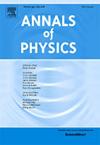温度对QCD轴子质量混合的影响
IF 3
3区 物理与天体物理
Q2 PHYSICS, MULTIDISCIPLINARY
引用次数: 0
摘要
在这项工作中,我们扩展了早期宇宙中的QCD轴子质量混合,并研究了混合中的温度效应。我们探索了两个ZN QCD轴子在QCD相变过程中发生质量混合的情况,得到了三种不同的混合情况:混合I、混合II和混合III。这些场景是通过微调轴子衰变常数、温度参数和n值来实现的。我们对这三种混合场景中的水平交叉现象进行了深入的分析,详细说明了它们发生的条件。值得注意的是,在混合I和II中,水平交叉先于QCD相变(TQCD)的临界温度,在TQCD处质量特征值的宇宙演化中具有最小的非本质差异。相比之下,混合III表现出独特的双电平交叉,发生在TQCD之前和TQCD处。尽管混合II和III之间的轴子演化表面上相似,但我们发现它们之间存在根本差异。此外,我们简要地讨论了混合情况下两个轴子之间能量密度的转变。这项工作有助于更深入地了解QCD轴子在早期宇宙中的作用及其对冷暗物质的潜在影响。本文章由计算机程序翻译,如有差异,请以英文原文为准。
On the temperature effects in QCD axion mass mixing
In this work, we extend the QCD axion mass mixing in the early Universe and investigate the temperature effects in the mixing. We explore the scenario where two QCD axions undergo mass mixing during the QCD phase transition, yielding three distinct mixing scenarios: the mixing I, II, and III. These scenarios are realized through fine-tuning of the axion decay constants, the temperature parameters, as well as the value of . We conduct a thorough analysis of the level crossing phenomena in these three mixing scenarios, detailing the conditions under which they occur. Notably, in the mixing I and II, the level crossing precedes the critical temperature of the QCD phase transition (), with minimal non-essential discrepancies in the cosmological evolution of the mass eigenvalues at . In contrast, the mixing III exhibits a unique double level crossings, occurring both before and at . Despite superficial similarities in axion evolution between the mixing II and III, we uncover fundamental differences between them. Additionally, we briefly address the transition in energy density between the two axions within our mixing scenarios. This work contributes to a deeper understanding of the role of the QCD axion in the early Universe and its potential implications for cold dark matter.
求助全文
通过发布文献求助,成功后即可免费获取论文全文。
去求助
来源期刊

Annals of Physics
物理-物理:综合
CiteScore
5.30
自引率
3.30%
发文量
211
审稿时长
47 days
期刊介绍:
Annals of Physics presents original work in all areas of basic theoretic physics research. Ideas are developed and fully explored, and thorough treatment is given to first principles and ultimate applications. Annals of Physics emphasizes clarity and intelligibility in the articles it publishes, thus making them as accessible as possible. Readers familiar with recent developments in the field are provided with sufficient detail and background to follow the arguments and understand their significance.
The Editors of the journal cover all fields of theoretical physics. Articles published in the journal are typically longer than 20 pages.
 求助内容:
求助内容: 应助结果提醒方式:
应助结果提醒方式:


